Complete Guide to Monthly Retainer Agreements
We've gathered everything you need to know about monthly retainer contracts in one post — from calculating your retainer fee to best practices for creating retainer contracts. Learn how to get your first retainer client!
— Propoze
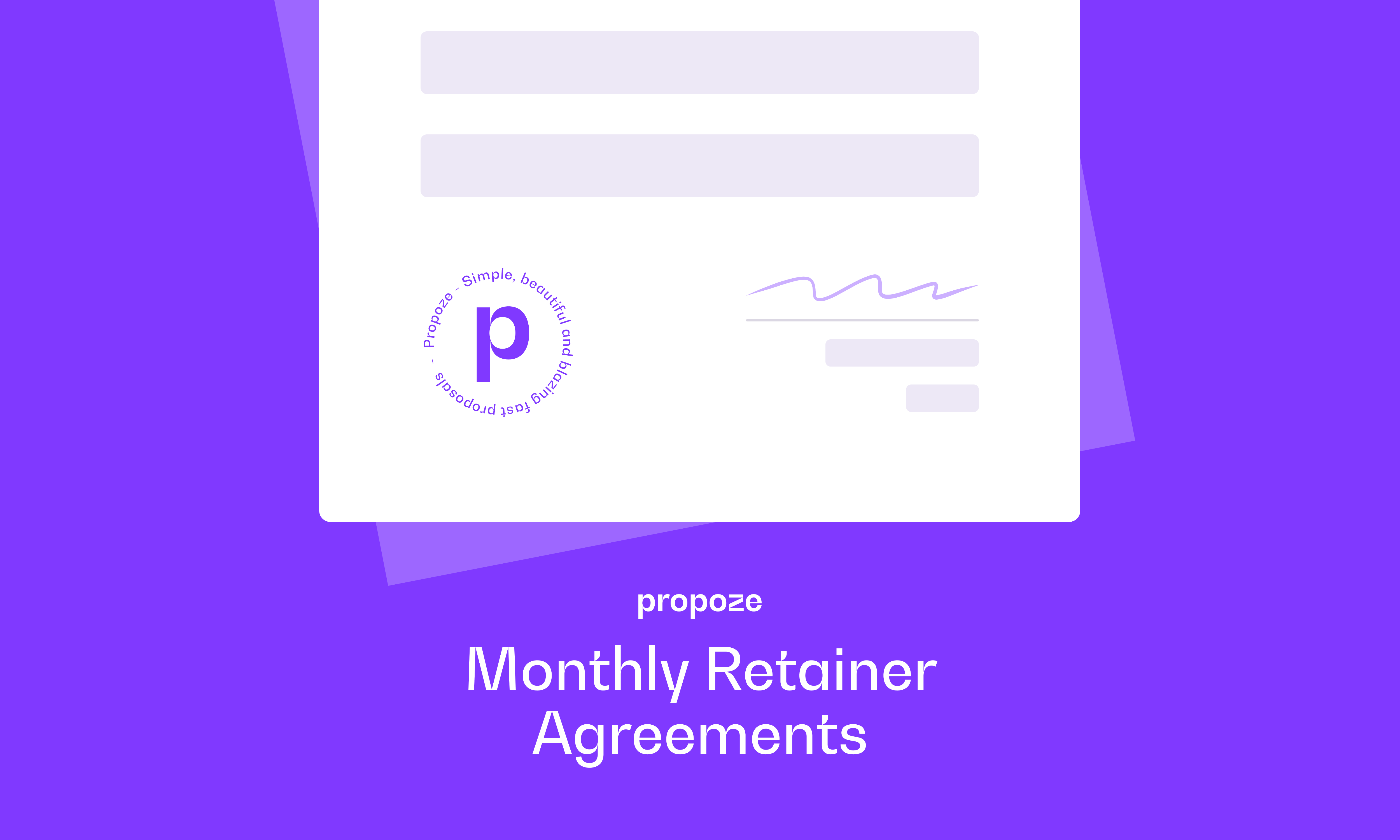
Are you tired of constantly chasing after new clients and unpredictable income? Monthly retainer agreements may be the solution for you.
Retainer agreements are a great way to secure predictable revenue by providing ongoing value to your clients for a fixed monthly fee.
In this blog post, we'll go through absolutely everything related to monthly retainer agreements - what they are, how to calculate the fee, how your clients can benefit from this, and how to create an ironclad agreement.
By the end, you'll have all the knowledge needed to start working with retainer contracts and secure a consistent income.
What is a monthly retainer?
A monthly retainer is an agreement between a service provider and a client, where the client pays a fixed fee on a monthly basis for a set of predetermined services.
There's barely a limit on what services can be sold with such agreements - marketing, consulting, legal, development, design...
In most cases, you can even ask for an advance payment if this is the first time in a working relationship with a particular client.
A great thing about this type of contract is that your retainer client receives continuous support without worrying about the cost of each individual service.
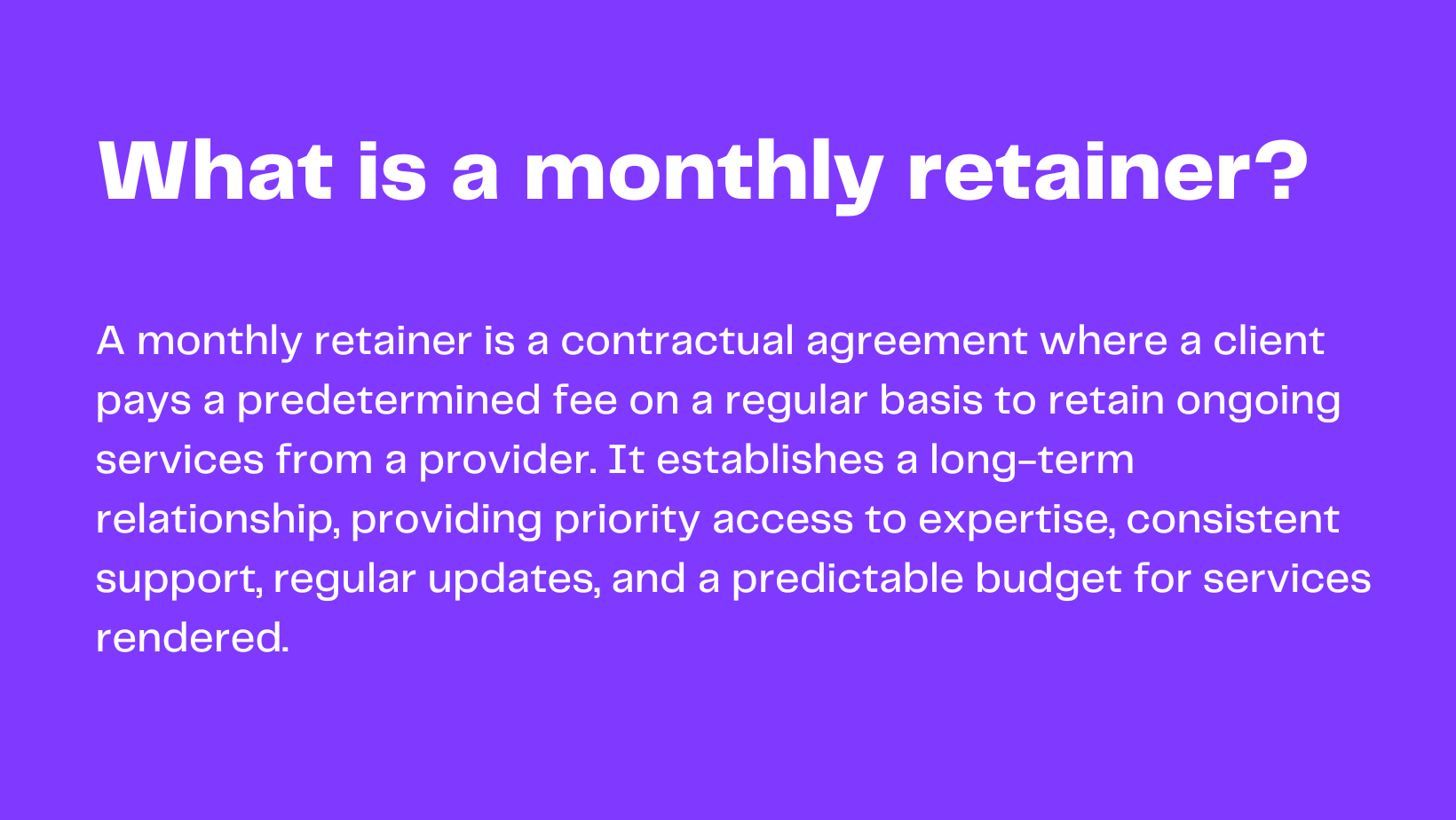
Needless to say, this type of agreement is beneficial for both parties.
Think of monthly retainers as a win-win: they give providers a steady paycheck and clients get the A-team on their side, always ready to go.
It's like having your cake and eating it too—better planning, smoother budgeting, and no last-minute scrambles.
Everyone knows what's coming up, so it's easier to make things happen without the guesswork.
Just a quick note. If you're looking to improve your sales efficiency and get more clients, you'll want to read this guide!
Understanding Monthly Retainers
Picking the right monthly retainer model is crucial—it's like choosing the perfect ingredient for your recipe.
By understanding each type, you ensure your project and budget are in perfect harmony.
#1 Time-Based Retainers
Clients pay for a set number of hours each month. This model offers flexibility in task allocation but requires careful tracking of hours.
Ideal for services requiring variable hours each month, like consulting or freelance work, where flexibility and adaptability are key.
#2 Project-Based Retainers
Suitable for ongoing projects with predictable requirements. Clients pay a monthly fee to have projects managed and executed over time.
Best suited for ongoing projects with clear deliverables, such as marketing campaigns or software development, where consistent progress is essential.
#3 Result-Based Retainers
Focuses on achieving specific outcomes or milestones. Payment is tied to the results delivered, making it ideal for performance-driven projects.
Perfect for goal-oriented projects, like SEO or performance marketing, where success is measured by specific outcomes.
#4 Mixed Retainers
A hybrid approach combining elements of the above models to suit complex or evolving needs.
A versatile option for services that need a blend of strategies, such as a mix of consulting, execution, and performance analysis.
What is the difference between hourly and retainer agreements?
Both hourly and retainer agreements are common ways service providers charge for their project work nowadays. While hourly billing is based on the exact amount of time you've spent on a project, retainer billing is based on a fixed fee for a set of predetermined services.
Hourly billing is great for clients who may only need occasional services or support. But, for service providers, hourly agreements may not be that attractive.
And the reasons are obvious. There is no guaranteed income, it all depends on how many work hours can you sell and how many potential clients and future projects you have lined up.
On the other hand, with retainer billing, you can secure stability for both yourself and the client. The client pays a fixed monthly fee for an agreed-upon set of services and there's no longer a need for further negotiation.
However, this opens doors to long-term projects, deepening your retainer relationship, and earning more money as a contractor. It makes sense, right?
What does a monthly retainer agreement include?
There are several key aspects of a monthly retainer agreement you need to take pay attention to.
Here's what these agreements usually include:
- Scope of services: This section outlines the specific services that the service provider will offer to the client on an ongoing basis.
- Retainer fee: This section outlines the fixed monthly fee that the client will pay for the services provided by the service provider.
- Payment terms: This section outlines the payment terms, including the due date, the accepted methods of payment, and any late payment fees.
- Termination clause: This section outlines the terms and conditions under which either party can terminate the agreement.
- Confidentiality clause: This section outlines the terms and conditions of confidentiality and non-disclosure of sensitive information.
- Intellectual property rights: This section outlines the ownership and use of any intellectual property that is created as part of the ongoing services.
- Duration of agreement: This section outlines the duration of the agreement and any provisions for renewal.
Overall, a retainer agreement is a highly detailed contract that protects both parties and will ensure you have a successful ongoing relationship.
When drafting the agreement, be sure to clearly outline the expectations and responsibilities of both parties.
Why should you use monthly retainer agreements?
There are a ton of benefits to using a retainer agreement.
Here are some of the reasons why you should consider monthly retainer work over hourly work.
Benefit #1: Stable income
With the retainer model, you always know how much income you can secure, regardless of the number of hours worked that month. As long as the service is delivered as promised, you'll be on the right track to prolonging your working relationship with your client.
Not to mention, you can better plan and manage your finances, scale your business, and work on improving your relationship with existing clients.
Benefit #2: A better relationship with your retainer clients
This goes without saying - most freelancers will prefer working on 2 longer projects (even if it's just one client), than doing 10 small 10-hour projects for other clients. As time goes on, you learn about the client's business and you get better acquainted with their needs.
Even better, you get to foster a relationship with your client and become their valuable business partner. When past clients who worked with you on long-term projects reach out again, asking for an upfront payment won't be taboo. And they can count on you to do your work properly.
Benefit #3: Less administrative work
Among freelancers, it's hard to find a person who enjoys doing administrative work. Essentially, no one pays you to do that, that's all on you. But when you secure a few retainer contracts, the number of hours spent on administrative work drastically reduces.
Of course, you can organize meetings with your retainer clients on a weekly basis, but there won't be any need to constantly negotiate and send new invoices. This may seem harmless, but it can easily become time-consuming.
Benefit #4: Better cash flow
It's easy to see why, right? If you're a service provider, you can receive a down payment before even starting work, rather than wait for payment after completion.
If you're having a problem with your cash flow, this can be a good way to improve it.
Right from the start, you know exactly how much income you can earn if you have, let's say, 4 clients on retainer. The chances are, you can get paid upfront for each of these projects and use that funds to fuel your outreach and even find a new client.
Benefit #5: Your clients get a better service
When you secure a long-term contract, you can better focus on providing a high-quality service, rather than worry about finding new clients or negotiating better rates.
It's as simple as that. For example, if you have a 6-month contract with a certain client, the chances are you won't worry that much about finding a new client. Instead, you'll want to focus on increasing the quality of your provided service and possibly prolonging that 6-month contract.
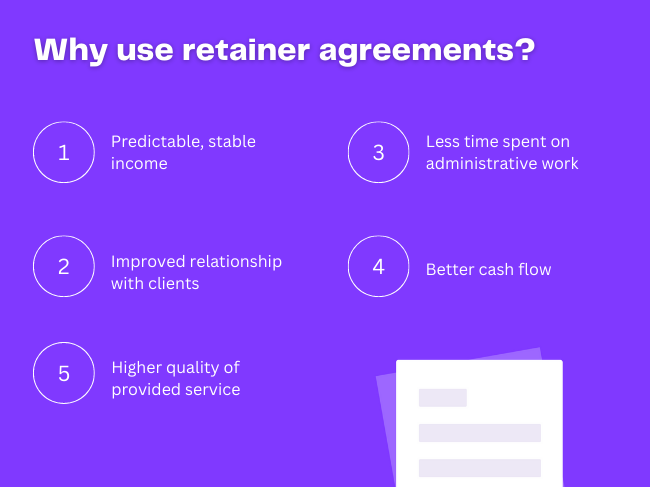
Earned vs. unearned retainer fee: what's the difference?
It's crucial to understand the difference between earned retainer fees and unearned retainer fees.
An earned retainer fee is a payment made in advance for work that has already been completed. For example, if an independent contractor has completed work for a client and the client has paid a retainer fee for that work, that fee is considered earned.
On the other hand, an unearned retainer fee is an upfront payment for work that has not yet been completed. For example, if a client pays a retainer fee at the beginning of the month, that fee is considered unearned until you have completed work for that month.
It's important to track earned and unearned retainer fees separately, as earned fees can be recognized as revenue immediately, while unearned fees need to be recognized over time as work is completed.
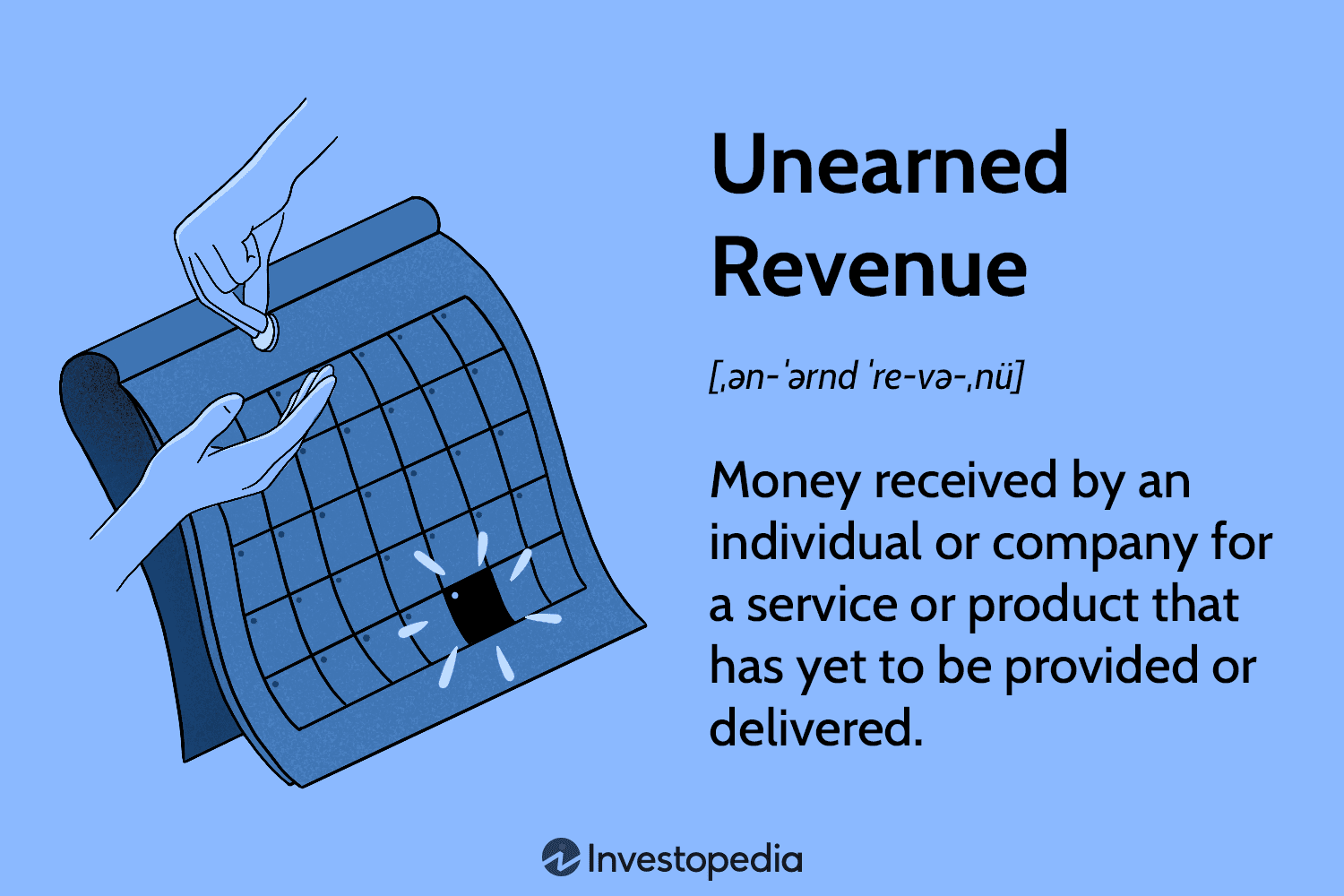
By understanding the difference between earned and unearned retainer fees, you can better manage your finances and ensure that you recognize revenue correctly.
How to calculate the monthly retainer fee?
Calculating retainer fees can be a bit tricky, as it requires considering a number of factors, such as the scope of work, the level of expertise required, and the retainer hours required.
Here are some steps that service providers can take to calculate a fair and reasonable monthly retainer fee.
Step #1: Determine the scope of work
The first thing you need to do before you calculate the monthly fee is to determine the scope of work for this project. This is unavoidable if you want to avoid scope creep.
To start, review the client's needs, identify which services are required, and try to estimate (as accurately as possible) the number of hours required (monthly) to complete the work.
Step #2: Evaluate your level of expertise
The next step is to evaluate how much value can you actually bring to the project. Let's be honest here - if you're just starting out, charging ludicrous fees for a few hours of work won't get you far.
Start by reviewing your qualifications and experience, check your track record, and research the market rates for similar services. But if you're, let's say, a freelance senior backend developer, you could charge a hefty amount.
Keep in mind, after your contract expires, there's always room for negotiating better rates - if there are some concrete results.
Step #3: Calculate your annual fee
If you've already done similar work for a few clients, you'll know how much should a certain service cost.
But if you have a certain revenue goal you want to reach, here's how to do it.
For example - your annual salary goal could be to earn $75,000 a year.
And you don't want to work 52 weeks/year, but only 48 weeks/year.
Also, you don't want 40 hours work weeks, but 30-hour work weeks.
So, let's divide this $75,000 by 48 working weeks. Your weekly target should, in this case, be around $1562/week.
Since your goal is to work 30 hours/week, think about charging $52/hour. Of course, you'll have to study your competitors' rates, check the industry standard, and take the level of your expertise into account. If your annual salary goal turns out to be below the industry standard, try recalculating your fees.
But what's important here is that you include expenses like:
- Taxes
- Equipment
- Subscriptions
- Utility bills
- Office rent
- etc.
Think about your desired profit margins, include the expected expenses, and you'll more easily calculate your hourly rate.
Step #4: Estimate how much time you need to spend on the project
Now that you've calculated your hourly rate, start estimating the time commitment required for this project.
Start by breaking down the work into smaller, specific tasks and estimating the time for each task.
Step #5: Calculate your monthly fee
Finally, you can calculate the monthly retainer fee by multiplying the estimated time commitment by the hourly rate. Your retainer fee should reflect the scope of work, your level of expertise, and the value that you can bring to the project.
By following these 5 steps, you can calculate a fair and reasonable monthly fee that reflects the value of your services and the needs of your clients.
The 7 best practices for creating monthly retainer contracts
Once you've decided to work with monthly retainers, you'll need to create a contract that will protect both your and your client's interests. More accurately, you'll want to clearly outline all the terms of your engagement with the client, so no scope creep shows up along the way.
Here are the seven best practices for creating monthly retainer contracts.
#1 Write a secure and binding contract
Here are some tips when creating a monthly retainer contract.
- Use only clear and concise language. Avoid using legal jargon and technical terms your client may be unfamiliar with.
- Clearly define the scope of work. To prevent any misunderstandings and ensure that both you and the client have a clear understanding of the work that needs to be done, be very specific when defining the scope of work.
- Set out your payment terms. Clearly state your payment terms so the client can know what are the fixed monthly expenses, include the retainer fee and any other additional fees that may apply. Also, be sure to state how and when you want for the client to complete the payment. This is necessary to ensure both you and the client are 100% clear on the financial terms of your contract.
- Include a confidentiality clause. If you're working with sensitive information, a confidentiality clause is a must. This is necessary to protect your client's information and ensure it doesn't get disclosed to any 3rd party.
- Specify the duration of the agreement. Be sure to specify the duration of your retainer agreement and include renewal terms. This will eliminate all possible confusion and misunderstandings over when the agreement is ending.
#2 Make room for additional work
One thing is for sure - the scope of work will change over time. And to avoid any dispute over additional work, it's good to make room for additional services in your contract.
Be sure to include a clause for additional work in your contract. This will help ensure that both parties fully understand when the additional work may be required and how will it be handled.
Also, think about future services you could offer to your client and how you can upsell the client in case new needs arise. And, of course, specify the payment terms for these occasions.
#3 Offer your services in different tiers
Not only is this tactic great for upselling your clients, but you can provide your potential client with several options to choose from right from the beginning.
Here are a few tips on how to introduce service tiers.
- Determine the different levels of your service. This includes different levels of access to your time, different types of deliverables, and different levels of support.
- Define the pricing for each tier. Ensure your pricing reflects the value of the services provided. Clients can easily see if your higher tiers have inflated prices.
- Clearly define the deliverables for each tier. To prevent any future misunderstanding, be sure to clearly outline what the client will receive depending on the level of service.
This tiered strategy can help you attract more clients and ensure you have a constant influx of both smaller and larger projects. Also, be sure to include a custom tier so you can be more flexible when a client contacts you regarding a long-term contract.
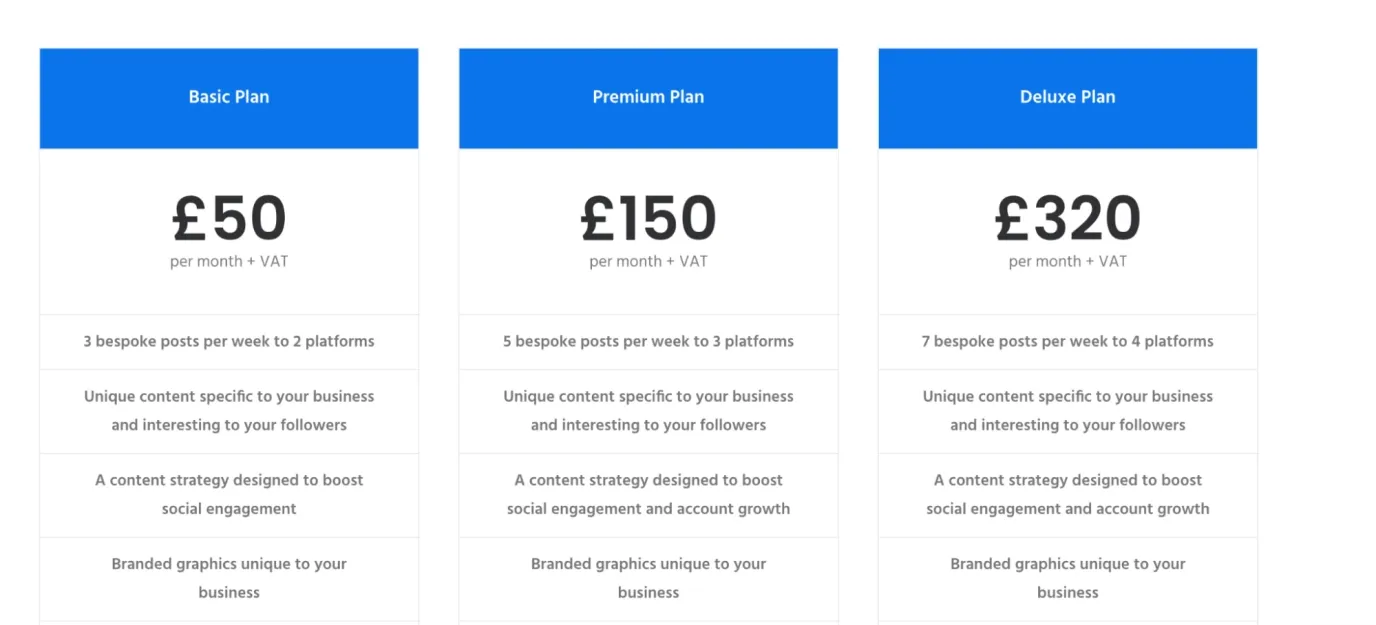
Here's an example of an agency using tiered pricing to attract clients of all sizes.
#4 Clearly define payment terms
This is one of the most important parts of every retainer contract and the part where you want zero misunderstandings. So, here's what you should do.
- Define the payment amount. This is extremely important. Be very precise when defining the payment amount for the retainer fee. This needs to be a fixed amount that is due on a monthly basis.
- Define the payment method. Now, this is all about how you want to receive the payment. Specify which payment method you want to use, be it a bank transfer, credit card payment, PayPal, or even a payment in crypto.
- Set the recurring payment due date. Here, you need to set a specific date. For example, it could be the 10th of each month.
- Define the late payment terms. This may include a late fee or a suspension of services until you receive the payment.
Defining the payment terms is highly important, as it is a basis for a professional relationship with your client, ensuring you get fairly compensated for your services.
#5 Send monthly reports to your clients
Sending monthly reports to your client is a crucial part of every successful retainer contract.
They keep your clients informed of the work you've done. This way, your clients will know more about the progress you've made toward achieving the set goals.
Here are some tips for creating monthly reports for your clients:
- Define the report format. Even though it's not necessary to include this in your retainer contract, it won't hurt to do so. Be clear when defining the report format, mention the level of detail and types of data you will include.
- Set a recurring reporting date. It's important to specify when exactly will you send the monthly reports. For example, it could be the 15th of each month, followed by a short meeting with the client to better showcase your results.
- Use clear language. Keep in mind, your clients aren't that fond of technical jargon. Try to explain any complex concept in simple terms.
- Highlight your achievements. If you've hit a certain milestone or achieved a goal, be sure to let your clients know that. This helps them see the value you're providing.
our clients see the value of your services.
This can help build trust and ensure that your clients are satisfied with your services.
Also, here's an example of a monthly sales report, including the most important metrics and presented with a large number of visuals.
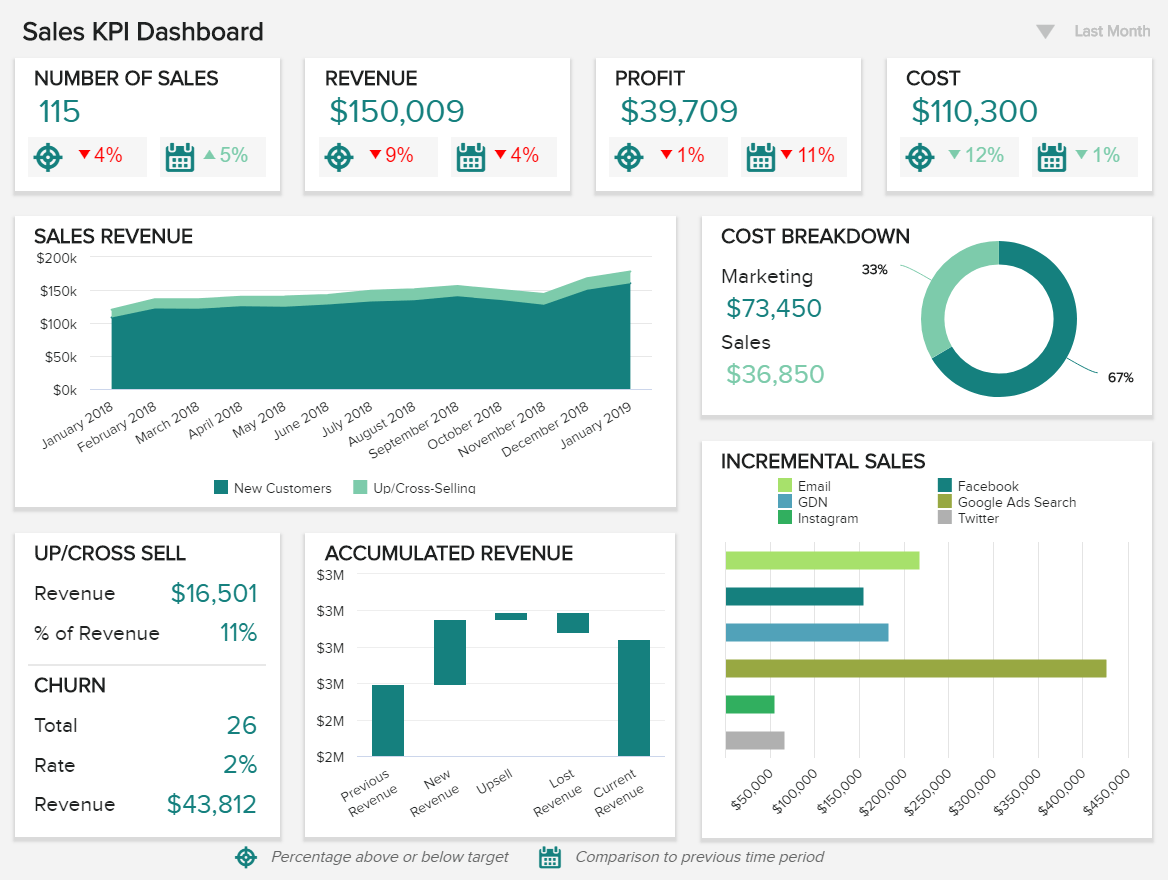
#6 Check your agreement from time to time
Be sure to check your retainer agreement occasionally to ensure that it's still meeting your and your client's needs. Chances are, some changes will be required.
First, set up a regular time to review your agreement. For example, this could be every 6 months or on a yearly basis.
Then, check for any changes in the scope of work or client needs. This is exactly what drives changes in the retainer agreement. Once you work out all the changes in the contract, reach out to your client and negotiate new terms for your ongoing work.
And if you're wondering how you can write an effective sales proposal that will get your client to agree to a new retainer agreement, here's the full guide.
#7 Create an offboarding strategy
Even though the retainer contracts are designed for long-term partnerships, there will come a time when either you or your client decide to end the collaboration.
For this transition to be smooth and without any misunderstandings, you'll need to employ an offboarding strategy.
Here's how to do it:
- Define the offboarding terms. This includes notice periods, final deliverables, and any other details you need to address. Of course, this should be included in the retainer agreement.
- Clearly communicate the offboarding with your client. Be open and honest when telling the client why you're ending the arrangement. Let them know what to expect during this offboarding period.
- Provide support to your clients. This may not be that necessary, but you don't want to burn the bridges you've been building for so long. Try helping your client find a replacement for your services or provide them with a list of recommended professionals.
- Collect all the feedback you can. This is extremely important. What your past and current clients have to say about your services impacts how well you can acquire new clients. You'll find out what you can improve, how to retain clients in the future, and you'll have a few testimonials you can use to generate trust with new clients.
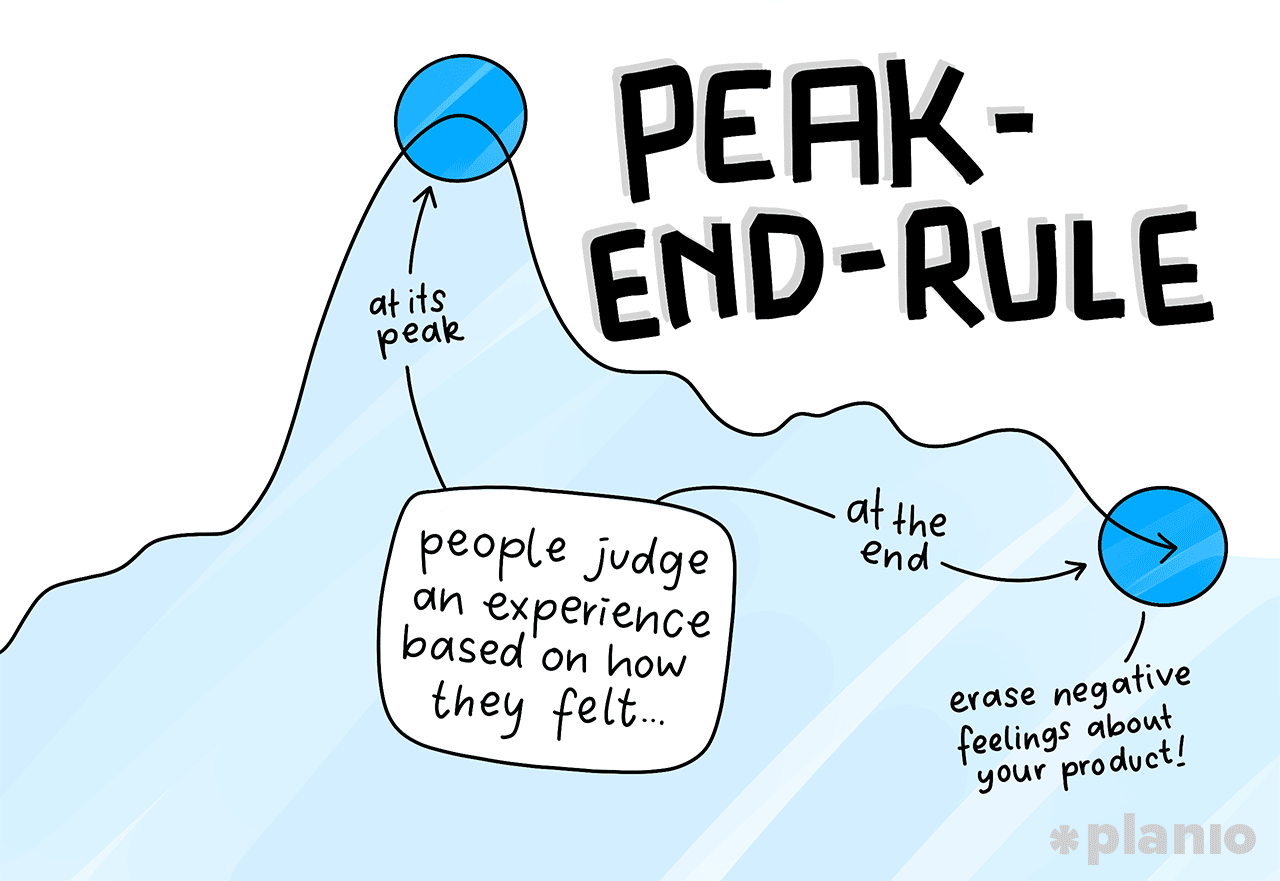
Keep in mind, if you do the offboarding the right way, the doors to that particular client are always open.
Not only this helps you preserve your reputation as a professional, but will help you get in touch again with that client and possibly make a new arrangement in the future.
How to negotiate a better monthly retainer fee?
Now, this is a very delicate process, but the most important part of this entire endeavor is to ensure you're fairly compensated for your services.
Here's what you can do to negotiate a better fee.
First, you'll need to understand how much value you're providing. Provide examples of how your services helped your previous clients and what kind of ROI they achieved. Knowing what you can bring to the table is the prerequisite for better fee negotiation.
Next, do your best to research the market. This includes researching your competitors and finding out what they are charging for similar services. Check their case studies, look at what they achieved, and how they've done it.
This will help you set a fair price for your services and give you more negotiation power.
Also, be sure to consider the long-term, rather than looking to get paid more in the short term. It may be tempting to ask for a high fee upfront but think about all the retainer fees you can charge if you secure a long-term contract.
And last, but not the least, be professional. Listen to your client's concerns and be open to compromise. Even though you may offer different tiers of service, not every client's needs fit into these tiers.
Remember, a positive working relationship is the key to the success of a retainer agreement.
Maximizing Success with Retainers
To ensure both providers and clients reap the maximum benefits from retainer agreements, it's crucial to address common challenges like scope creep, while fostering clear and frequent communication.
Here are actionable tips to consider:
- Manage Scope Creep: Establish clear boundaries for the scope of work from the outset. Should additional tasks arise, utilize a predefined process for their assessment and incorporation, potentially through an amendment to the agreement or an additional work order.
- Importance of Regular Reviews: Schedule periodic reviews of the agreement to ensure it continues to meet the evolving needs of both parties. These sessions are opportunities to adjust the scope, discuss new objectives, and refine strategies based on performance and feedback.
- Effective Communication Practices: Maintain open lines of communication through regular check-ins and updates. Utilize project management tools or platforms that allow for transparent tracking of tasks and milestones. Encourage feedback from both sides to identify areas for improvement and celebrate successes.
Ready for your next monthly retainer agreement?
All in all, deciding whether a monthly retainer agreement is right for you depends on your unique circumstances.
However, understanding the differences between hourly and retainer agreements is a must.
In this blog post, you've learned how clients can benefit from monthly retainers, how to calculate your retainer fee, and how to negotiate a better one.
With these tips and considerations in mind, you are now ready to build a successful and sustainable business model with monthly retainers.
And if you need any help with your sales processes, please let us know! We're all about helping you close more deals. And what better way to do it than with Propoze - a block-based sales proposal software!
You know how important a sales proposal is in the grand scheme of things. We'll help you create, polish, and send proposals extremely fast.
And if you need any help building a better proposal - you know what to do. Reach out to us at support@propoze.app and we'll be on it ASAP.
Follow us on our LinkedIn, Twitter, and Instagram accounts! We post regularly on proposal and sales-related topics.